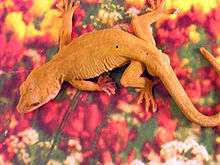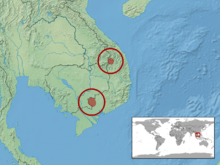Golden gecko
The golden gecko (Gekko badenii) is a species of gecko, a lizard in the family Gekkonidae. The species is native to Vietnam.
| Golden gecko | |
|---|---|
 | |
| Scientific classification | |
| Kingdom: | Animalia |
| Phylum: | Chordata |
| Class: | Reptilia |
| Order: | Squamata |
| Family: | Gekkonidae |
| Genus: | Gekko |
| Species: | G. badenii |
| Binomial name | |
| Gekko badenii Szczerbak & Nekrasova, 1994[2] | |
 | |
| Synonyms | |
Etymology
The specific name, badenii, refers to Núi Bà Đen (Black Lady Mountain where Bà Đen is Black Lady), to which this species is indigenous.[3]
Description
The golden gecko gets its common name from the gold-colored scales on its body. Males grow to around 7 to 8 inches (18 to 20 cm) in total length (including tail), while females stay around 5 to 6 inches (13 to 15 cm).[4] Males have a longer tail base, with fleshy knobs at the base of the tail. Pores appear on the insides of the legs. Females have none of these.
Geographic range and habitat
G. badenii has been reported from the Tây Ninh Province and Kon Tum Province of southern Vietnam (the latter following the recognition of Gekko ulikovskii as a synonym of this species). There is no definite information about its habitat, which is likely to be lowland rainforest.[1]
Diet
The golden gecko is primarily an insectivore but will also take some fruit. The golden gecko hydrates by drinking water from rainfall collecting on leaves.
As a pet
The golden gecko is not very popular in the pet trade, so most specimens are wild caught. It requires a terrarium of a minimum of 20 US gallons (about 80 litres) for an adult, though a vertical 18x18x24 Exo Terra tank could accommodate an adult due to the greater space. These geckos should not be housed together because they will fight. Captive hatchlings feed daily, and adults only need food every 5–6 days. Juveniles and adults will eat crickets and meal worms, wax worms, and fruits, such as bananas and mangos, which are rich in calcium.[4]
References
- Nguyen NS, Golynsky E, Milto K, Nguyen TQ (2018). "Gekko badenii ". The IUCN Red List of Threatened Species 2018: e.T178554A112309489. https://dx.doi.org/10.2305/IUCN.UK.2018-2.RLTS.T178554A112309489.en. Downloaded on 20 December 2018.
- Nguyen, Quang Truong; Schmitz, Andreas; Bohme, Wolfgang (April 2010). "Gekko ulikovskii Darevsky & Orlov, 1994: a junior synonym of Gekko badenii Szczerbak & Nekrasova, 1994" (PDF). Bonn Zoological Bulletin. 57 (1): 15–17. Archived from the original (PDF) on 5 May 2012. Retrieved 17 March 2013.
- Beolens, Bo; Watkins, Michael; Grayson, Michael (2011).The Eponym Dictionary of Reptiles. Baltimore: Johns Hopkins University Press. xiii + 296 pp. ISBN 978-1-4214-0135-5. ("Baden", p. 14).
- "Golden Gecko Care Guide". www.reptilesncritters.com. Retrieved 2016-05-16.
- "Gekko badenii ". The Reptile Database. www.reptile-database.org.
Further reading
- [ Sczerbak NN, Nekrosova OD ] (1994). "[Contribution to knowledge of gekko lizards of southern Vietnam with description of new species (Reptilia, Gekkonidae)]". [Vestnik Zoologii, Kiev ] 1994 (1): 48–52. (Gekko badenii, new species, p. 49). (in Russian).
| Wikimedia Commons has media related to Gekko badenii. |
